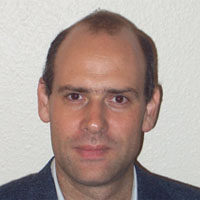Conférence CRMAA avec le Professeur Paolo Samori (Strasbourg)

Titre : Taming Complexity in Dynamic Molecular Materials: Tailoring Low-Dimensional Multifunctional Nanostructures.
Endroit : Pavillon J.A.-Bombardier, salle 1035 à 11 h
Hôte : William Skene
Cette conférence sera prononcée par le professeur Paolo Samori de l'Institut de Science et d'Ingénierie Supramoléculaires au sein de l'Université de Strasbourg. Elle est commanditée par le Centre de recherche sur les materiaux auto-assemblés (CRMAA) et sera donnée en anglais.
Résumé : Responsive supramolecularly engineered hybrid materials are key in multifunctional (opto)electronics. However, their practical use requires the optimization of the self-assembly of multimodular architectures at surfaces using non-conventional methods, their controlled manipulation and responsiveness to external stimuli, and the quantitative study of various physico-chemical properties at distinct length- and time-scales. My lecture will review our recent findings on:
1) The STM monitoring of the reversible on-surface reactivity under thermodynamic control making use for the first time of dynamic covalent chemistry approaches at the solid-liquid interface. We focused our attention to the double imine formation between 4-(hexadecyloxy)benzaldehyde and different α,ω-diamines as well as reversible bistransimination. In particular, we provided direct evidence of the ability of adsorption free energy to act as a physical agent that shift equilibriums and eventually drives completion of a reaction thereby selecting a given constituent of a dynamic covalent library.
2) The harnessing of the yield of exfoliation of graphene in liquid media by mastering the supramolecular approach via combination with ad-hoc functional molecules, leading ultimately to the bottom-up formation of optically responsive graphene based nanocomposites for electronics.
3) The bottom-up formation of graphene based 3D covalent frameworks with tunable intersheet distance, exhibiting large specific surface areas which determine an ability to adsorb CO2 which is the highest reported among carbon-based materials and extremely high performance in supercapacitors.
4) The tailoring multicomponent films comprising photochromic systems and semiconducting molecules, and their exploitation to realise multifunctional devices such as optically switchable field-effect transistors.
Information supplémentaire
Annonce PDF de la conférence
Emplacement : Université de Montréal - Pavillon J.-Armand-Bombardier